|
The Pony Express Stations of Utah in Historical Perspective
|

|
THE STATIONS (continued)
Willow Creek (Six-Mile)
Utah No. 24 (controversial)
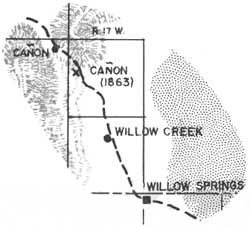 |
Location: SE1/4NE1/4 Section 16, Township 10 South, Range 17 West, Salt Lake Meridian. Six miles from Willow Springs Station. The 1875 cadastral survey plat (Figure 30), locates a cabin, springs, and connecting roads at a location along Six-Mile Creek. This, coupled with historic written accounts and knowledge that Pete Joyce built and occupied a log cabin at this location, suggests its use as a station house. The authors do not necessarily support the idea that a station was located here but the following evidence, from excerpts of Nick Wilson's story in "Utah and the Pony Express" presents a favorable case. |
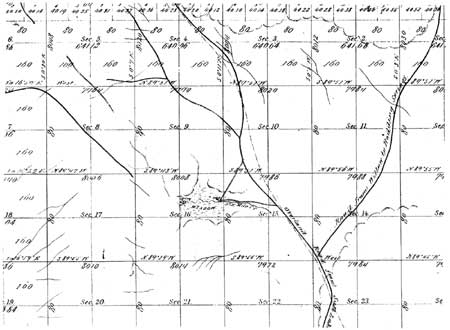
|
| Figure 30. Willow Creek T. 10 S., R. 17 W. Sec. 16 1875 Survey. (click on image for a PDF version) |
The text, including punctuation etc., remains unchanged.
Peter Neece, our home station keeper, was a big strong man and a good rider. He was put to breaking some of these wild mustangs for the boys to ride. Generally, just as soon as the hostler could lead them in and out of the stable without getting his head knocked off, they were considered tame, and very likely they had been handled enough to make them mean.
My home station was Shell Creek (Nevada). I rode from Shell Creek to Deep Creek (Utah), and one day the Indians killed the rider out on the desert, and when I was to meet him at Deep Creek, he was not there. I went to the next station, Willow Creek, the first station over the mountain, and there I found out that he had been killed. My horse was about jaded by this time, so I had to stay there to let him rest I would have had to start back in the night as soon as the horse got so he could travel, if those Indians had not come upon us. About four a 'clock in the afternoon, seven Indians rode up to the station and asked for something to eat. Peter Neece picked up a sack with about twenty pounds of flour in it and offered it to them, but they would not have that little bit, they wanted a sack of flour apiece. Then he threw it back into the house and told them to get out, and that he wouldn't give them a thing. This made them pretty mad, and as they passed a shed about four or five rods from the house, they each shot an arrow into a poor, old lame cow, that was standing under the shed. When Neece saw them do that, it made him mad, too, and he jerked out a couple of pistols and commenced shooting at them. He killed two of the Indians and they fell off their horse there. The others ran. He said, 'Now boys, we will have a time of it tonight. There are about thirty of those Indians camped in the canyon there and they will be upon us as soon as it gets dark, and we will have a fight.' A man by the name of Lynch happened to be there at the time. He had bragged a good deal about what he would do and we looked upon him as a sort of desperado and a very brave man. I felt pretty safe until he weakened and commenced to cry, then I wanted all of us to get on our horses and skip for the next station, but Pete said, 'No, we will load up all the old guns that are around here and be ready for them when they come. There are four of us and we can stand off the whole bunch of them. Well, just a little before dark, we could see a big dust over toward the mouth of the canyon, and we knew they were coming. It was bout six miles from the canyon to the station.
Pete thought it would be a good thing to go out a hundred yards or so and lie down in the brush and surprise them as they came up. When we got out there he had us lie down about four or five feet apart. 'Now,' he said, 'when you fire, jump out to one side, so if they shoot at the blaze of your gun, you will not be there.' We all took our places, and you bet, I lay close to the ground. Pretty soon we could hear their horses feet striking the ground, and it seemed to me as if there were thousands of them, and such yells as they let out, I never heard before. The sounds were coming straight towards us, and I thought they were going to run right over us. It was sandy where we lay, with little humps. Finally the Indians got close enough for us to shoot. Pete shot and jumped to one side. I had two pistols, one in each hand, cocked all ready to pull the trigger, and was crawling on my elbows and knees. Each time he would shoot, I saw him jump. Soon they were all shooting and each time they shot, I would jump. I never shot at all. After I had jumped a good many times, I happened to land in a little wash or ravine. I guess my back came pretty nearly level with the top of it. Anyhow, I pressed myself down so I could get in. I don't know how I felt, I was so scared. I lay there and listened until I could hear no more shooting, but I thought I could hear the horses' hoofs beating on the hard ground near me until I found out it was only my heart beating. After a while, I raised my head a little and looked off towards the desert and I could see those humps of sand covered with greese-woods. They looked exactly like Indians on horses, and I could see several of them near the wash.
I crouched down again and lay there for a long time, maybe two hours. Finally everything was very still, so I thought I would go around and see if my horse was where I had staked him, and if he was, I would go back to my station in Deep Creek and tell them that the boys were all killed and I was the only one that had got away. Well, as I went crawling around the house on my elbows and knees, just as easily as I could, with both pistols ready, I saw a light shinning between the logs in the back part of the house. I thought the house must be full of Indians, so I decided to lie there a while and see what they were doing. I lay there for some time listening and watching and then I heard one of the men speak. 'Did you find anything of him?' Another answered, 'No, I guess he is gone.' Then I knew it was the boys, but I lay there until I heard the door shut, then I slipped up and peeped through the crack and saw that all three of them were there all right. I was too much ashamed to go in but finally I went around and opened the door. When I stepped in Pete called out, 'Hello! Here he is. How far did you chase them? I knew you would stay with them. I told the fellows here you would bring back at least half a dozen of them.' I think they killed five Indians that night. [49]
This story has been tied to Willow Springs Station at Callao, Utah, but portions of the story do not fit the area.
First of all Pete Neece was named as home station keeper at Schell Creek. Then he is named as station keeper at Willow Creek, not Willow Springs. Pete Joyce has been named as the man who settled at Six-Mile. This could be a misnomer on stations because one has to cross Willow Creek before one gets to Six-Mile Creek when coming south from Overland Canyon. The story notes that the station was six miles from the canyon. Callao or Willow Springs Station is more than twelve miles from the canyon. Wilson states that as he lay in a small wash he raised his head a little and looked off towards the desert. Callao is in the desert, Six-Mile is up on the bench (See Figure 31). Laying in a wash at Six-Mile one can look toward the desert, but while laying in a wash at Willow Creek, by raising one's head a little, one probably cannot see more than ten feet. Later Wilson states "I saw a light shinning between the logs in the back part of the house." The 1868 photograph from which Figure 28 was produced shows the Willow Springs Pony Express Station and the Wells Fargo and Company Stage building to be constructed of adobe, not logs. Cadastral plats made by the General Land Office show the Willow Springs stable across the road from the Kearney Ranch Hotel. If this skirmish happened at Willow Springs (Callao), why didn't these men go across the road and get help from Kearney or why didn't Wilson even mention Kearney? F.J. Kearney was already settled in this area and grew hay for the line. Another cadastral plat shows the cabin site at Six-Mile. One must note the road turns up the slope coming either from the north or south and that Wilson said that the Indians rode up to where they were laying.
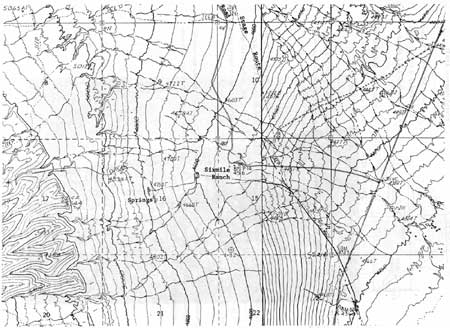
|
| Figure 31. Willow Creek USGS Quadrangle . (click on image for a PDF version) |
Sir Richard Burton also adds a piece of evidence to this story. He states,
As we advanced (toward the Deep Creek Mountains) the land improved, the salt disappearing, the grass was splendidly green, and approaching the station we passed Willow Creek where gopher holes and snipes, willows and wild roses told of life and gladdened the eye. The station lay on a bench beyond the slope. The station keeper was an Irishman (Pete Joyce?), one of the few men amongst the Saints. Nothing could be fouler than the log hut.
Note the statements: "We passed Willow Creek"—Willow Creek, a slough, does pass Willow Springs Station but is north and west of the site; Burton was traveling northwest, and "the station lay on a bench beyond the slope." Note also he mentions a log hut. This description does not fit Willow Springs but it does fit Six-Mile. The evidence presented here is not conclusive. Hopefully future investigations will end the controversy.
Round (Canyon 1863)
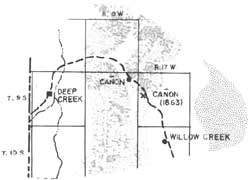 |
Location: SW1/4NW1/4 Section 18, Township 9 South, Range 17 West, Salt Lake Meridian.
Six miles from Willow Creek and twelve miles from Willow Springs Station.
Canyon Station was strategically built in 1863 high above the mouth of Overland Canyon to replace an earlier, indefensible station located up Overland Canyon about two or three miles. Indians had beseiged and burned the original Canyon Station earlier the same year.
Locally called Round Station, this recent connotation originates because prior to archaeological investigations in 1974, the only discernible feature was a round, relatively complete, fortified rock structure, which included gunports. This had been interpreted as the station house. Excavations revealed the actual station house foundation (as well as the corral area) to be east of the round fortification. The Gale Parker's recall their grandfather having spoke of a roof being on the fortification.
Artifacts collected indicate no extensive use after 1870. The Bureau of Land Management has stabilized the fortification and the station foundation, and has provided an interpretive ramada and parking facilities (See Photos 36 & 37).
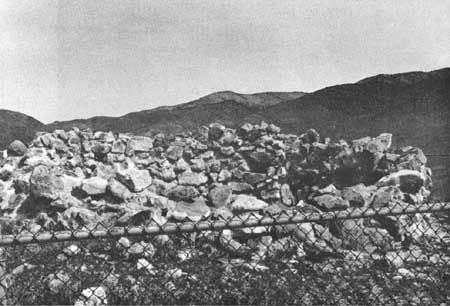
|
| Photo 36. The defensive structure at Round Station. Built in 1863 (note the gunports; BLM photo 1978). |
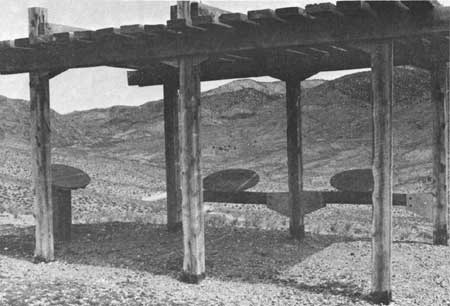
|
| Photo 37. BLM interpretive ramada at the Round Station site looking towards Overland Canyon (BLM photo 1978). |
Burn't (original, Canyon, and Burnout)
Utah No. 25 Non-contract Station
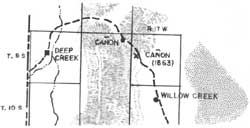 |
Location: Unknown.
The original Canyon Station, also known as Burn't Station, had been built by Howard Egan as an Express Station and was first described in August of 1861. [50] A marker built and placed by the Civilian Conservation Corp (C.C.C.) is apparently located improperly in Township 9 South, Range 18 West, Section 2 (SE1/4NW1/4). The authors are informed that the station was in the form of a dugout located at the mouth of Blood Canyon, so named because of the Indian attack in 1863. [51] A ground search, by the authors, located a possible dugout location, however, archaeological testing is necessary to substantiate these findings. Other evidence indicates the site may be to the west on Clifton Flat. Descriptions vary on structural features. Apparently a dugout with stable or barn was built and possibly a log house. [52] Figure 32 depicts a typical dugout for the region.
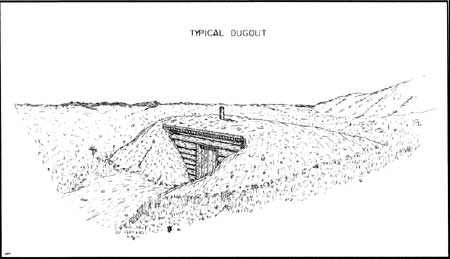
|
| Figure 32. Typical dugout. |
The following by Howard Egan, is an account of Indian attack on Canyon Station in 1863.
The Indians waited till the men had been called to breakfast in the dugout, and were all down in the hole without guns, all except the hostler, William Riley, who was currying a horse just outside the south door of the stable at the time of the first alarm, and he was shot through the ankle and the bone broken short off. He started down the canyon on the run, but did not get very far before he was caught and killed.
The men at breakfast were mostly all killed as they came out of the dugout to reach their arms that were staked in the south end of the barn. Not one of them ever reached his gun. One man, though wounded, tried to excape by running down the canyon as Riley did. He got further away, but was caught and killed, and, as he was some bald on top of his head, and a good growth of whiskers on his chin, they scalped that and left him where he fell . . . They took the clothes off every man and left them just where they fell. All this had been done without a shot being fired by the white men. A most complete surprise and massacre. [53]
Graves of some of the victims are located at the site. After being destroyed in 1863, the facilities were relocated to the east (Round Station).
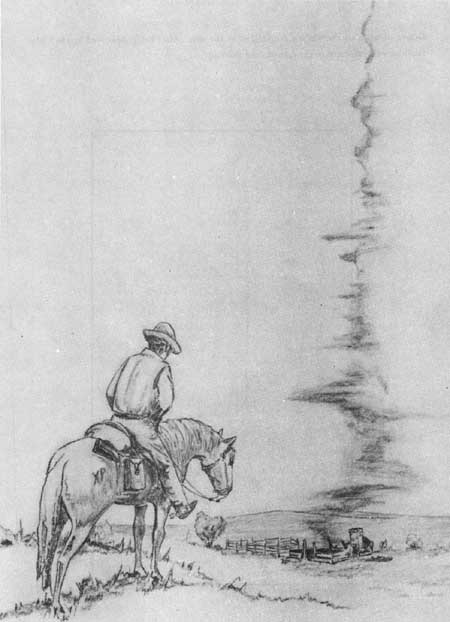
Deep Creek (Egan's)
Utah No. 26 Contract Station
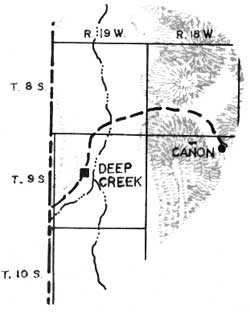 |
Location: Lot 4, Section 9, Township 9 South, Range 19 West, Salt Lake Meridian. (See Figure 33). Fourteen miles from Round Station via the original trail. Deep Creek was the home of Howard Egan, the division superintendent for service between Salt Lake City, Utah, and Roberts Creek (near Eureka, Nevada). This well-equipped and service functioning facility was the most westerly station located within the present boundaries of Utah. The western boundary of the Utah Territory at this time was the California state line and Genoa the most westerly Utah Territory station (See Figure 3). |
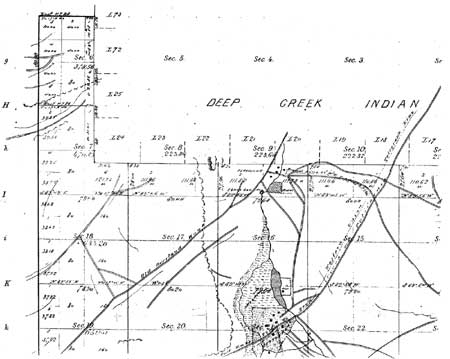
|
| Figure 33. Deep Creek T. 9 S., R. 19 W. Sec. 9 1875 Survey. (click on image for a PDF version) |
Harrison Sevier was the station master. Several photographs exist. Buildings included an adobe station, house, and barn (See Photo 38). The telegraph established a repeater station at this location in 1861 with George Ferguson being the telegrapher. [54] The station site is presently on the ranch of Sidney (DeVerl) Nichols, Jr. Incidentally, Joan and Hilda Erikson paid for the last telegraph message to be sent from this station in 1869. [55]
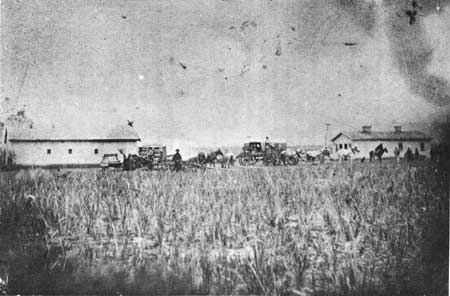
|
| Photo 38. Early photo of Deep Creek Station. |
The Pony Express is steeped in story and legend. Stories of the men who made it work are extant.
To get an idea of what the life and times were like, a story that was uncovered from the National Archives about Camp Floyd is relevant:
On September 2, 1859, Second Lieutenant John Green of the Second Dragoons was ordered to take Post at or near Tyler Spring on Simpson's "new route" to California to intercept and apprehend deserters. Part of the orders read "It is rumored that there are Indians on this road who are robbing immigrants - be on your guard therefore against surprise from them."
On July 8, 1860, Lieutenant Green was ordered west to overtake a party of cattle thieves. This time the orders read, "On over hauling the party, should the thieves give Lieut. Green even a pretext, he will without fail, fire upon them. It is not advisable to take prisoners." The cattle were found and returned to Rush Valley and put in care of a civilian herder by the name of Kalapse on July 13, 1860. On July 18, 1860, another order was issued stating that the retrieved cattle were again stolen and possibly driven north toward Grantsville. The last sentence of this order says "Should the least resistance be offered you in the discharge of this duty, you will not hesitate to exterminate the rascles."
* * *
As has been stated, the human element was not always the only cause of danger for the Pony Express. Richard E. Egan, caught in a blizzard made his way to the Mill Creek bridge south of Salt Lake City where his horse slipped on ice and they plunged into the cold creek. After climbing out of the water, Egan caught his horse and rode the rest of the way into Salt Lake and delivered his mail.
* * *
A bugle was used by some riders to warn of their approach to the station so their exchange mount would be ready upon their arrival. In Nebraska, William Campbell left his pistol and rifle at his home station to save weight as there were heavy snow drifts across the trail. As he traveled, he passed a pack of hungry wolves which gave chase. When a wolf would come too close, Campbell would lean from the saddle and blow the bugle into the wolf's face thus frightening them away temporarily until he was able to reach the next station.
This paper has not been written to destroy any legends, but rather to present new facts and ask new questions which deal with the Pony Express Stations throughout the present State of Utah. The great epoch of the Pony Express is now over a hundred years old and unless every remaining thread of information is brought to light for other researchers, the full and true story may never be told.

| <<< Previous | <<< Contents>>> | Next >>> |
ut/2/sec2e.htm
Last Updated: 18-Jan-2008